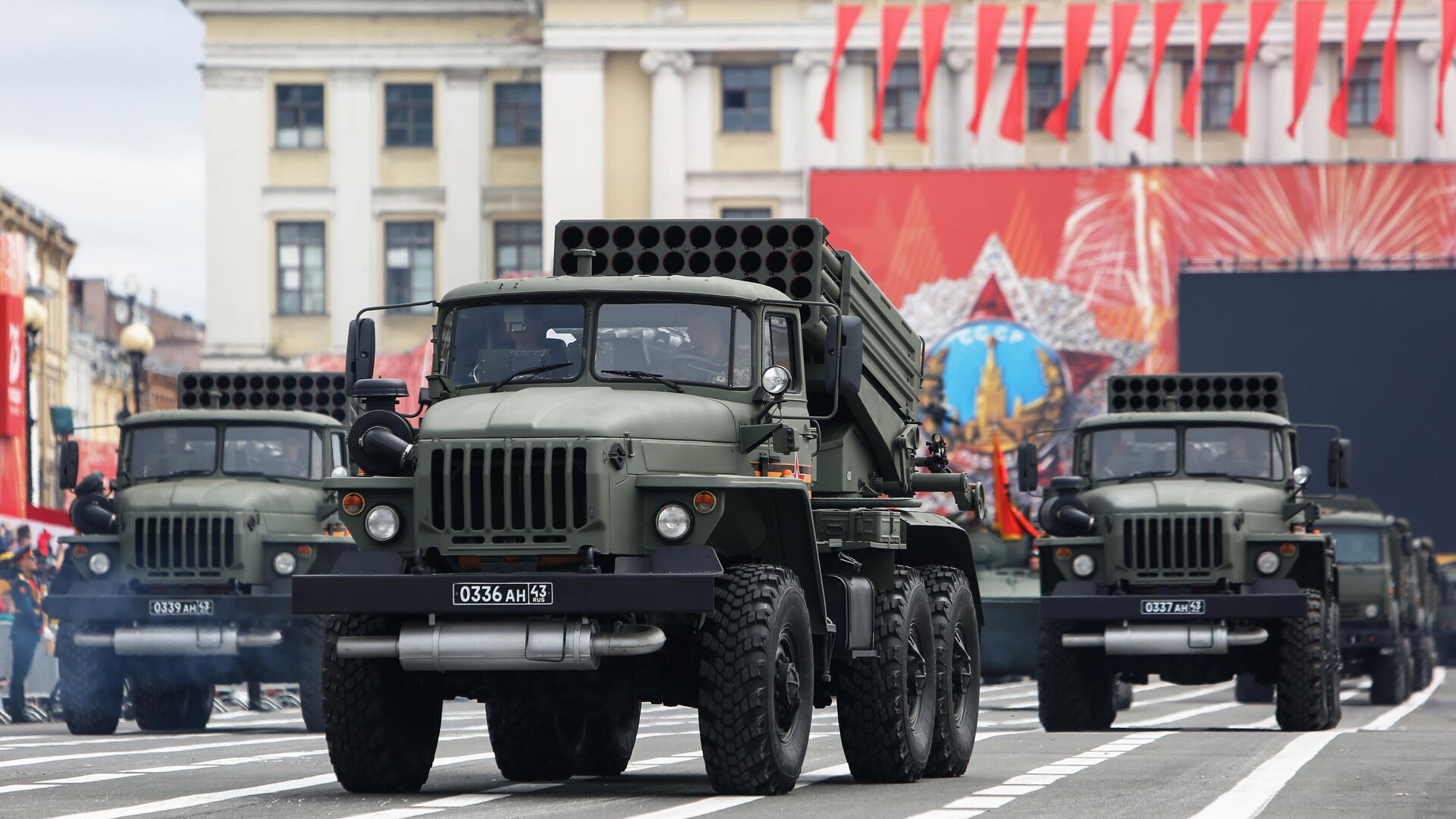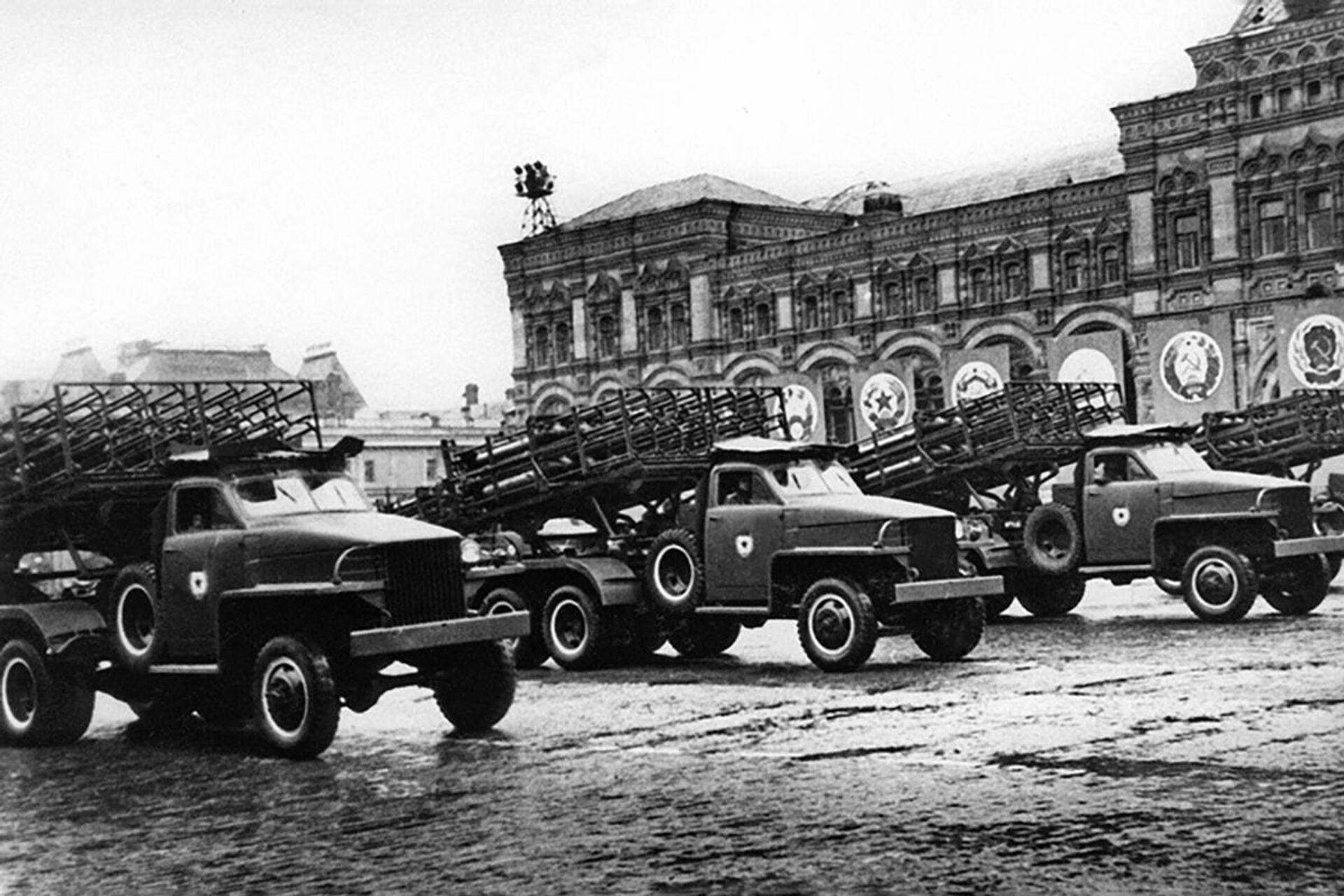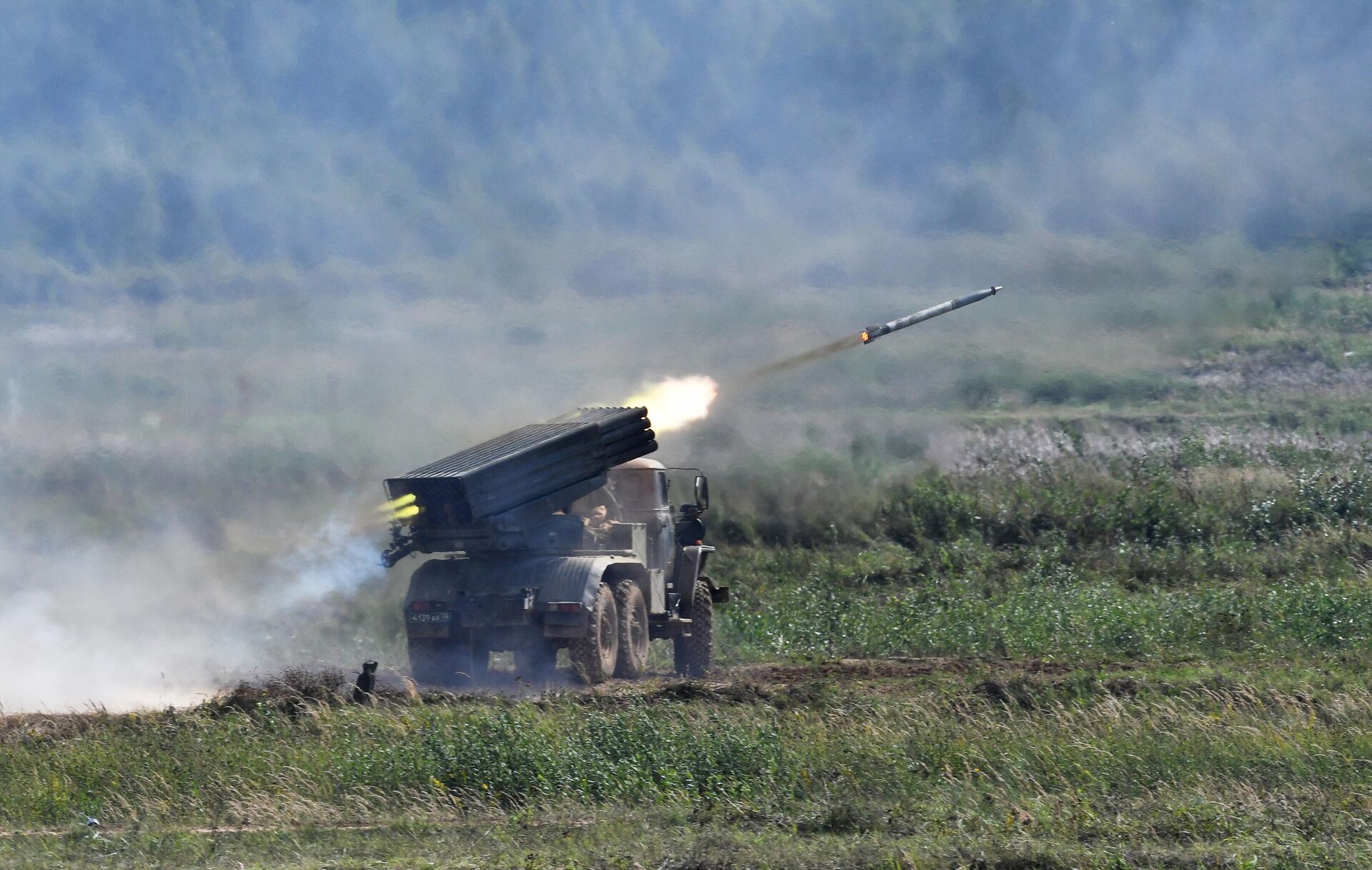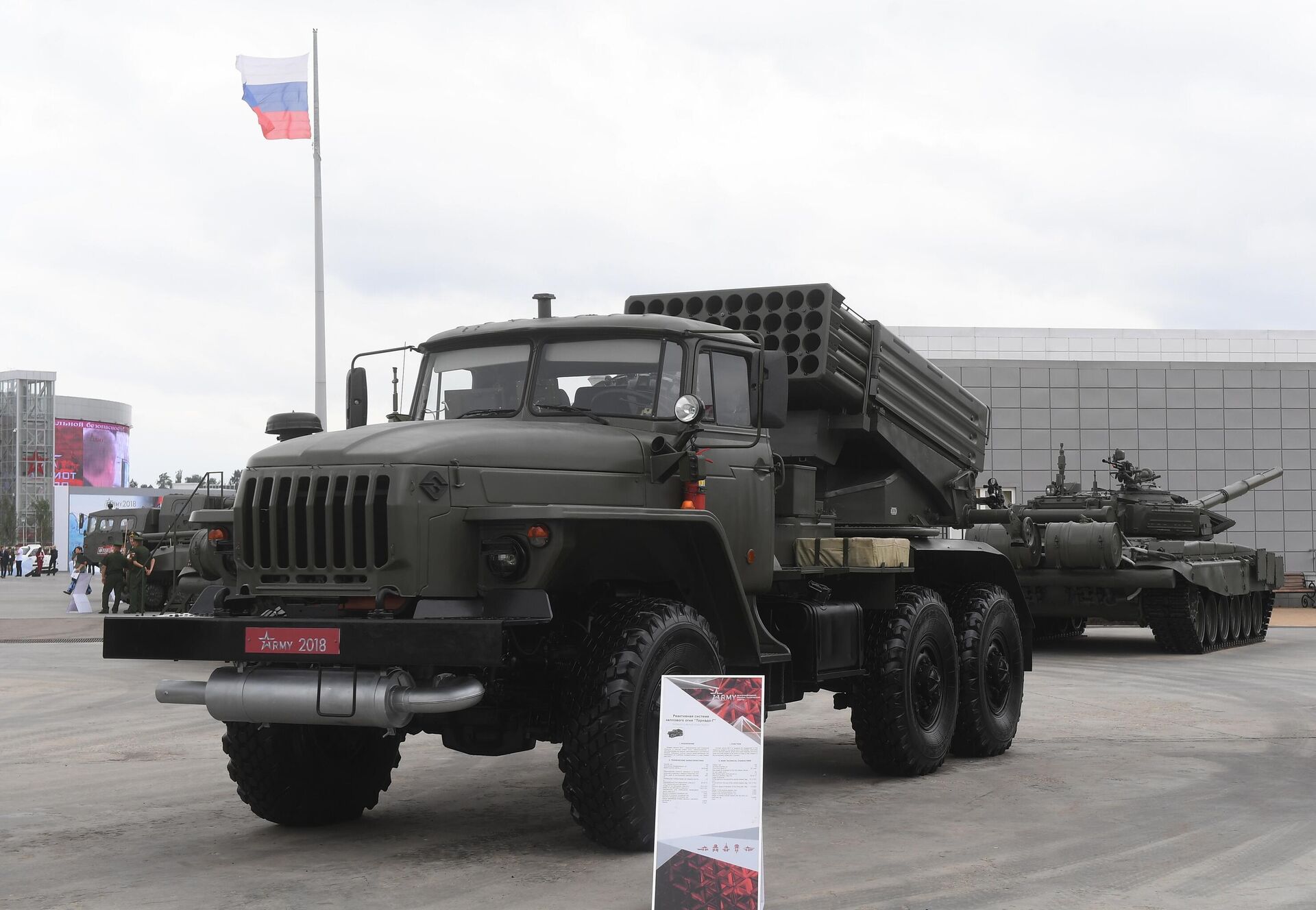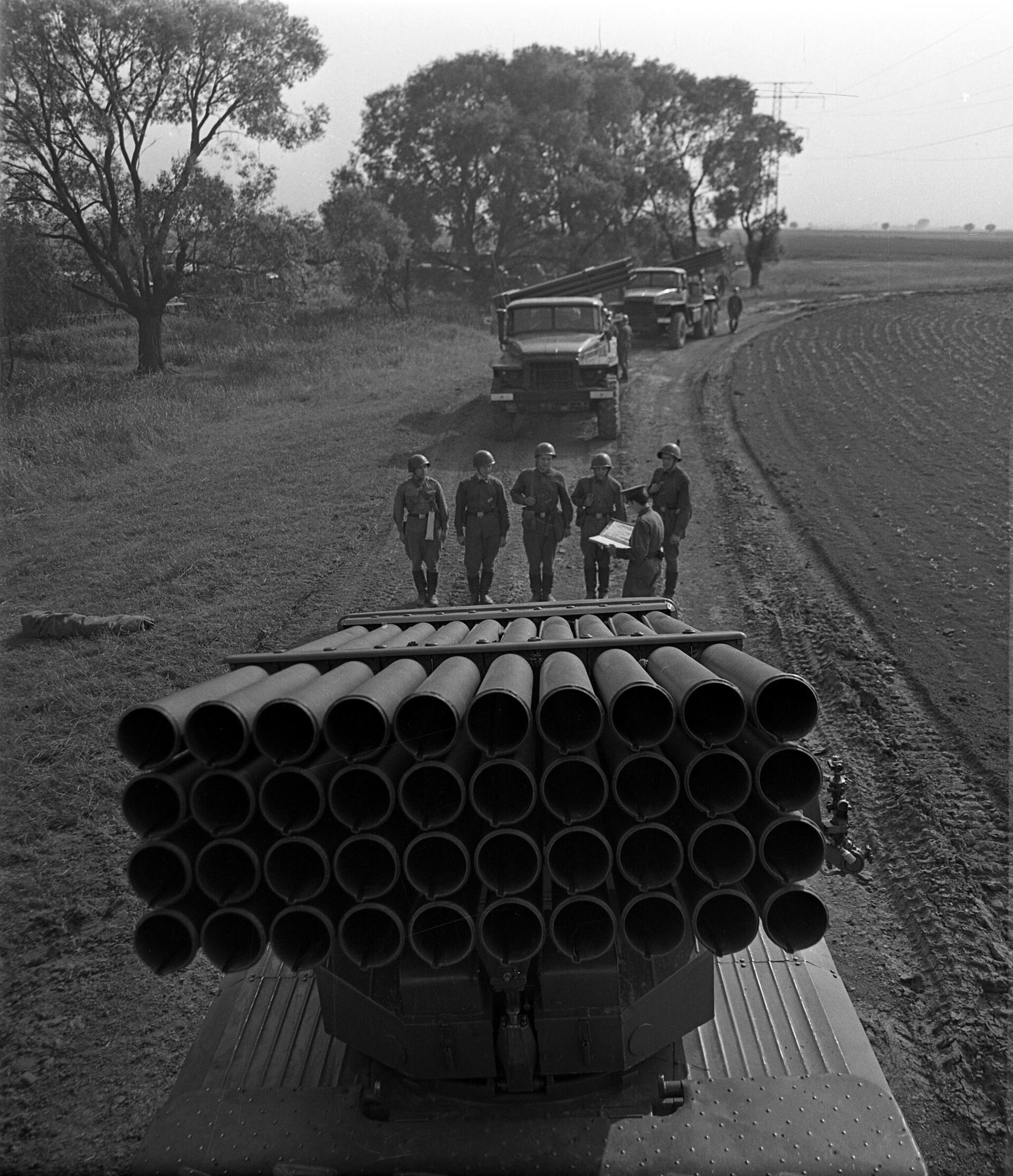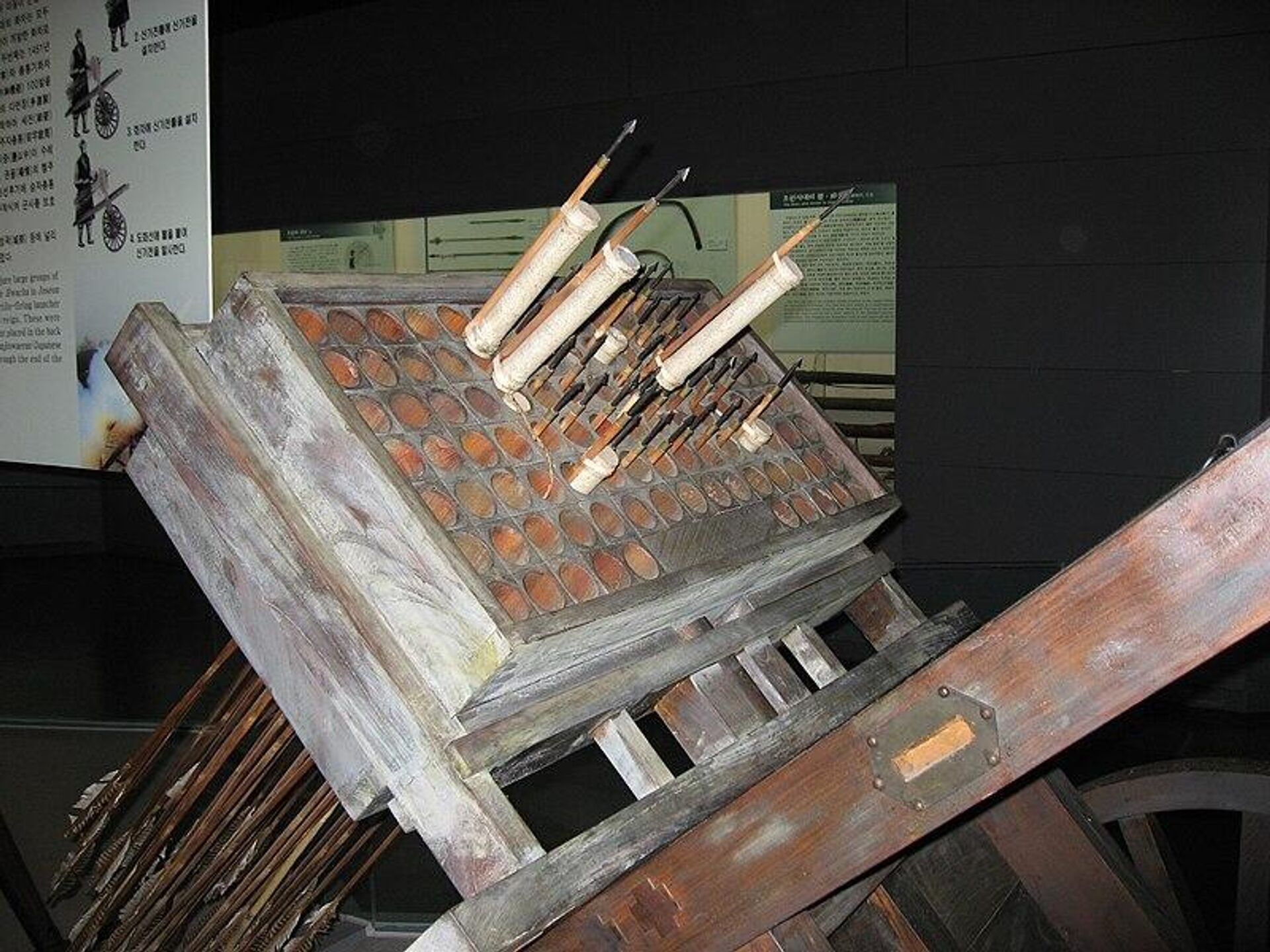https://sputnikglobe.com/20230115/what-is-the-tornado-g-rocket-artillery-system-1106350157.html
What is the Tornado-G Rocket Artillery System?
What is the Tornado-G Rocket Artillery System?
Sputnik International
Among the systems spotted in the field in the Donbass is the Tornado-G, a new Russian take on a well-known Soviet rocket artillery system. Find out more about the Tornado-G’s history and characteristics.
2023-01-15T15:38+0000
2023-01-15T15:38+0000
2023-01-15T15:38+0000
military
bm-21 grad
grad multiple-launch rocket system
grad rockets
grad rocket launcher
grad
tornado-g
katyusha
artillery
multiple-launch rocket systems (mlrs)
https://cdn1.img.sputnikglobe.com/img/07e7/01/0f/1106349314_0:160:3073:1889_1920x0_80_0_0_297fdeb42c76d24aadc981ff3a9dbf36.jpg
Last week, the Russian military released footage of Tornado-G multiple launch rocket systems (MRLS) firing on a convoy of Ukrainian forces traveling under the cover of darkness somewhere in the Donetsk People’s Republic, with thermal cameras of recon units showing the detonation of a dozen or more shells, which lit up the surrounding night sky.What is an MLRS?As the name suggests, MLRSs are a weapons platform capable of firing multiple rockets (guided or unguided). When used en masse, their task is to 'blanket' large areas of territory with explosives to destroy concentrations of troops, tanks, and damage critical infrastructure facilities like airport runways, ports and other facilities, terrorizing enemy forces in the process.The concept of a multiple rocket launcher goes back to at least the 15th century and the Korean hwacha (lit. 'fire cart'), used by Korean forces against invading Japanese hordes. The technology was developed further in the late 18th and early 19th centuries, and used in the British Royal Navy raid on Boulogne, France in 1804, the bombardment of Copenhagen in 1807, and the British-American War of 1812. Russian weapons makers experimented with the concept from the 1820s onward, using a multiple rocket system design during the Russo-Turkish War of 1828-1829.The idea of using MLRS weapons was returned to during the interwar years in the first half of the 20th century, with both Soviet and German researchers working on perfecting the technology amid advances in rocketry, metallurgy, and vehicle mobility. During World War II, the legendary Katyusha rocket launchers, designed by Soviet Russian and Ukrainian rocket scientists Ivan Gvay, Vladimir Galkovsky, Andrei Kostikov and others between 1938 and 1941, helped turn the tide against advancing fascist troops and ultimately push them back into the heart of Europe.What is the Tornado-G and How Many Does Russia Have?The Tornado-G is the product of the deep modernization of the Soviet-designed BM-21 Grad self-propelled 122mm multiple rocket launch system. Developed between the late 1990s and 2000s by the Tula-based Splav MLRS maker, and fielded with the Russian military from the early 2010s onward, the Tornado-G’s main distinguishing feature is its onboard computer and GLONASS satellite navigation-assisted automated fire control system – created by the Signal Research Institute. The system enables the Tornado-G’s crew to fire the system’s complement of up to forty 122mm rockets without leaving their cabin, and can be prepared to fire in as little as one minute.The Tornado-G is based on a 6x6 Kamaz or Ural military truck, but can theoretically be attached to other vehicles, provided they have the necessary weight capacity and horsepower to lug it around. Owing to its electronic systems, the complement of crew needed to operate has been reduced from six for the original BM-21 to 2-3 troops for the Tornado-G. The system weighs roughly 14,000 kg fully loaded.The Tornado-G can fire a range of standard BM-21 ammunition, as well as specially designed extended range munitions meant to increase its firing range to 40, 70 or even 90 km. Standard rockets weigh between 66 and 70 kg, and have a warhead mass between 25 and 35 kg. Available rockets include anti-armor HEAT submunitions, and cumulative fragmentation projectiles which can penetrate armor of between 60 and 170 mm thick – enough to destroy or critically damage most light tanks, infantry fighting vehicles, armored personnel carriers, mortar batteries and command posts.Like all MLRS systems, and most kinds of heavy guns and howitzers, the Tornado-G has a large ‘dead zone’ in which it cannot fire – in this case 4 km, and has no armor protection, which means it needs to be secured and kept well away from areas where enemy forces might break through, or risk capture or destruction.The Russian military first confirmed that Tornado-Gs were operating in Ukraine in November. Russia is estimated to have about 180 Tornado-Gs in its inventory. An export version of the system was approved in 2018.How Much Do Tornado-Gs Cost?Information on the Tornado-G's cost is hard to come by, and no official figures are available. However, according to a 2017 report in Russian business media, the Ministry of Defense contracted producers to build 36 MLRS systems for 1.07 billion rubles, or about 29.94 million rubles apiece (that's about $453,600 US under today's exchange rate). For comparison, a single HIMARS MLRS costs anywhere from $3.5 million and $5.1 million, according to media reports.What is the Tornado-G’s Predecessor?The BM-21 Grad (lit. ‘Hail’) is the most widely-used light MLRS artillery in the world. Between 1960 and 1988, over 8,500 BM-21s were produced by the Soviet Union, with allied countries and Soviet client states producing tens of thousands more indendently over six decades (China alone has close to a dozen domestically produced Grad variants in its inventory). Grads are operated by most former Soviet republics, including Russia and Ukraine, much of NATO’s Eastern European flank (including Poland, Romania, Bulgaria and Croatia), North Korea, Vietnam, India, most of Africa and five nation in Latin America, or over 60 countries in total. Grads are so pervasive in some parts of the world that they’re even operated by militias and non-state actors. Several countries that the systems were never originally exported to also have dozens of Grads in their inventory – like Israel, which has 58 Grads in storage, and the United States, which bought 75 between 1992 and 2010 from Romania and Ukraine for “evaluation purposes.”The systems were used in most Cold War conflicts of the mid-to-late 20th century, and crises in the modern era – from the Vietnam and Ogaden wars to the Iran-Iraq War, the Soviet War in Afghanistan, the Yugoslav Wars, Libya, the dirty war in Syria, Yemen, and the current Russia-Ukraine conflict.Russia’s Ground Forces operate about 550 BM-21 Grads, and over 2,000 are held in storage. The Russian Navy’s Coastal Troops operate 36 Grads. Ukraine is thought to have up to 185 Grads. The rocket artillery has been used extensively by Ukrainian and Donbass militia forces since 2014, and the Kharkov Machine Building Design Bureau has created a modernized BM-21 known as the Verba (lit. ‘Willow’) featuring modernized navigation and communications systems and mounted aboard a KrAZ trucks.
Sputnik International
feedback@sputniknews.com
+74956456601
MIA „Rosiya Segodnya“
2023
News
en_EN
Sputnik International
feedback@sputniknews.com
+74956456601
MIA „Rosiya Segodnya“
Sputnik International
feedback@sputniknews.com
+74956456601
MIA „Rosiya Segodnya“
tornado-g rockets, tornado-g mlrs, tornado-g multiple launch rocket system, mlrs weapon, tornado-g 122mm mlrs, mlrs, grad, rocket, rocket artillery, what is mlrs weapon, tornado-g mlrs, what is the best mlrs system, what are tornado rockets, how many mlrs does ukraine have, how many mlrs does russia have, what is the meaning of mlrs, how much does a mlrs cost, tornado-g mlrs price, tornado mlrs vs himars
tornado-g rockets, tornado-g mlrs, tornado-g multiple launch rocket system, mlrs weapon, tornado-g 122mm mlrs, mlrs, grad, rocket, rocket artillery, what is mlrs weapon, tornado-g mlrs, what is the best mlrs system, what are tornado rockets, how many mlrs does ukraine have, how many mlrs does russia have, what is the meaning of mlrs, how much does a mlrs cost, tornado-g mlrs price, tornado mlrs vs himars
What is the Tornado-G Rocket Artillery System?
Russia has concentrated an array of firepower in the Donbass against heavily entrenched forces of Ukraine’s regular Army, ultra-nationalist volunteers and foreign mercs. Among the systems spotted in the field is the Tornado-G, a new take on a well-known Soviet rocket artillery system. Find out more about the Tornado-G’s history and characteristics.
Last week, the Russian military released
footage of Tornado-G multiple launch rocket systems (MRLS) firing on a convoy of Ukrainian forces traveling under the cover of darkness somewhere in the Donetsk People’s Republic, with thermal cameras of recon units showing the detonation of a dozen or more shells, which lit up the surrounding night sky.
As the name suggests, MLRSs are a weapons platform capable of firing multiple rockets (guided or unguided). When used en masse, their task is to 'blanket' large areas of territory with explosives to destroy concentrations of troops, tanks, and damage critical infrastructure facilities like airport runways, ports and other facilities, terrorizing enemy forces in the process.
The concept of a multiple rocket launcher goes back to at least the 15th century and the Korean hwacha (lit. 'fire cart'), used by Korean forces against invading Japanese hordes. The technology was developed further in the late 18th and early 19th centuries, and used in the British Royal Navy raid on Boulogne, France in 1804, the bombardment of Copenhagen in 1807, and the British-American War of 1812. Russian weapons makers experimented with the concept from the 1820s onward, using a multiple rocket system design during the Russo-Turkish War of 1828-1829.
The idea of using MLRS weapons was returned to during the interwar years in the first half of the 20th century, with both Soviet and German researchers working on perfecting the technology amid advances in rocketry, metallurgy, and vehicle mobility. During World War II, the legendary Katyusha rocket launchers, designed by Soviet Russian and Ukrainian rocket scientists Ivan Gvay, Vladimir Galkovsky, Andrei Kostikov and others between 1938 and 1941, helped turn the tide against advancing fascist troops and ultimately push them back into the heart of Europe.
What is the Tornado-G and How Many Does Russia Have?
The Tornado-G is the product of the deep modernization of the Soviet-designed BM-21 Grad self-propelled 122mm multiple rocket launch system. Developed between the late 1990s and 2000s by the Tula-based Splav MLRS maker, and fielded with the Russian military from the early 2010s onward, the Tornado-G’s main distinguishing feature is its onboard computer and GLONASS satellite navigation-assisted automated fire control system – created by the Signal Research Institute. The system enables the Tornado-G’s crew to fire the system’s complement of up to forty 122mm rockets without leaving their cabin, and can be prepared to fire in as little as one minute.
The Tornado-G is based on a 6x6 Kamaz or Ural military truck, but can theoretically be attached to other vehicles, provided they have the necessary weight capacity and horsepower to lug it around. Owing to its electronic systems, the complement of crew needed to operate has been reduced from six for the original BM-21 to 2-3 troops for the Tornado-G. The system weighs roughly 14,000 kg fully loaded.
The Tornado-G can fire a range of standard BM-21 ammunition, as well as specially designed extended range munitions meant to increase its firing range to 40, 70 or even 90 km. Standard rockets weigh between 66 and 70 kg, and have a warhead mass between 25 and 35 kg. Available rockets include anti-armor HEAT submunitions, and cumulative fragmentation projectiles which can penetrate armor of between 60 and 170 mm thick – enough to destroy or critically damage most light tanks, infantry fighting vehicles, armored personnel carriers, mortar batteries and command posts.
Like all MLRS systems, and most kinds of heavy guns and howitzers, the Tornado-G has a large ‘dead zone’ in which it cannot fire – in this case 4 km, and has no armor protection, which means it needs to be secured and kept well away from areas where enemy forces might break through, or risk capture or destruction.
The Russian military first confirmed that Tornado-Gs were operating in Ukraine in November. Russia is estimated to have about 180 Tornado-Gs in its inventory. An export version of the system was approved in 2018.
How Much Do Tornado-Gs Cost?
Information on the Tornado-G's cost is hard to come by, and no official figures are available. However, according to a 2017 report in Russian
business media, the Ministry of Defense contracted producers to build 36 MLRS systems for 1.07 billion rubles, or about 29.94 million rubles apiece (that's
about $453,600 US under today's exchange rate). For comparison, a single HIMARS MLRS costs anywhere from
$3.5 million and
$5.1 million, according to media reports.
What is the Tornado-G’s Predecessor?
The BM-21 Grad (lit. ‘Hail’) is the most widely-used light MLRS artillery in the world. Between 1960 and 1988, over 8,500 BM-21s were produced by the Soviet Union, with allied countries and Soviet client states producing tens of thousands more indendently over six decades (China alone has close to a dozen domestically produced Grad variants in its inventory). Grads are operated by most former Soviet republics, including Russia and Ukraine, much of NATO’s Eastern European flank (including Poland, Romania, Bulgaria and Croatia), North Korea, Vietnam, India, most of Africa and five nation in Latin America, or over 60 countries in total. Grads are so pervasive in some parts of the world that they’re even operated by militias and non-state actors. Several countries that the systems were never originally exported to also have dozens of Grads in their inventory – like Israel, which has 58 Grads in storage, and the United States, which bought 75 between 1992 and 2010 from Romania and Ukraine for “evaluation purposes.”
The systems were used in most Cold War conflicts of the mid-to-late 20th century, and crises in the modern era – from the Vietnam and Ogaden wars to the Iran-Iraq War, the Soviet War in Afghanistan, the Yugoslav Wars, Libya, the dirty war in Syria, Yemen, and the current Russia-Ukraine conflict.
Russia’s Ground Forces operate about 550 BM-21 Grads, and over 2,000 are held in storage. The Russian Navy’s Coastal Troops operate 36 Grads. Ukraine is thought to have up to 185 Grads. The rocket artillery has been used extensively by Ukrainian and Donbass militia forces since 2014, and the Kharkov Machine Building Design Bureau has created a modernized BM-21 known as the Verba (lit. ‘Willow’) featuring modernized navigation and communications systems and mounted aboard a KrAZ trucks.
